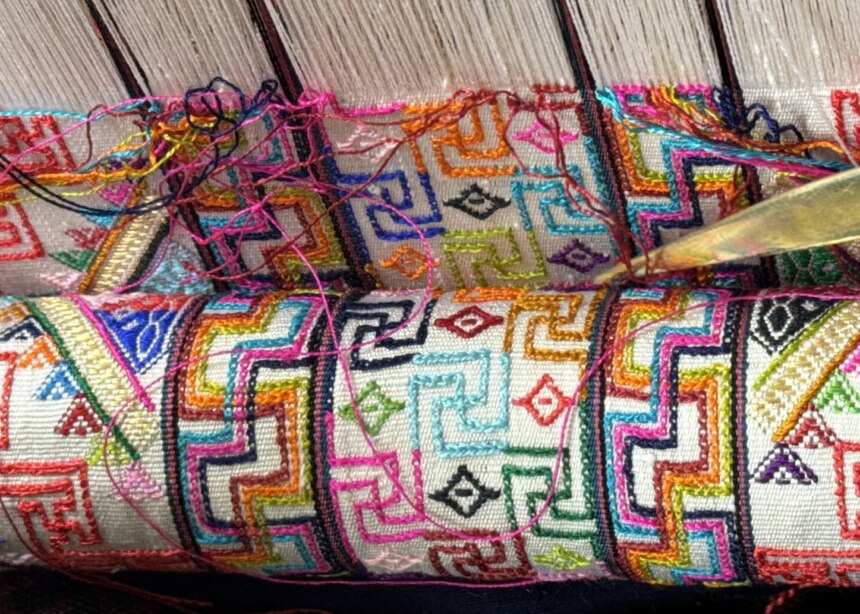Join us for a fabulous textiles and arts tour to Bhutan for an authentic adventure in the Land of Happiness!
Total 18 nights.
Bhutan Government Tax
The Bhutanese government levies a mandatory tax that is applied to all tourists visiting the country. This tax goes to the government for the country’s infrastructure: schools, hospitals, roads, and social services. This government tax is included in the tour price. Obviously we have no control over a government tax but it is excellent for the Bhutanese people – and will eventually help tourists with better roads and infrastructure.
Bhutan is a small landlocked country in the eastern Himalayas, with a progressive young king and a charismatic queen who promotes traditional textiles.
The Bhutanese have safeguarded their Buddhist culture and ancient way of life, and it’s the traditional aspects that lend great charm and interest to the country. We’ll spend the most time in the less-visited and more rural eastern regions where the weaving and little villages are spectacular!
During our travels in Bhutan, we’ll visit many fabulous Buddhist temples called dzongs, and attend festivals called tshechus which the local people attend in their best handwoven, traditional clothing. Everyone loves the ultra-decorated buildings, the crisp air, the festival dancers, the dark green forests, and the stunning handwoven clothing.
TRIP HIGHLIGHTS
- See fabulous Buddhist festivals with masked and costumed dancers
Meet talented weavers and observe their labor-intensive textile techniques
Travel through stunning Himalayan scenery with prayer flags galore.
Learn to make traditional Bhutanese foods in our cooking class
Admire ancient Buddhist temples (dzongs) built centuries ago, without nails, and with brightly painted details.
Visit families renowned for their natural silk textile dyeing and weaving.
What’s Included in The Trip?

From West to East
We’ll fly into the Paro Airport from New Delhi, India, and start our adventure in the western part of Bhutan. The highlight in Paro is climbing up to the fabulous Tiger’s Nest Monastery.
It was constructed on the side of a cliff in 1692, near the cave where Guru Rinpoche first meditated. It’s said that he’s the person who introduced Buddhism into Bhutan. A legend relates that Rinpoche flew from Tibet to this steep cliff on the back of a tigress, thus giving it the name “Tiger’s Nest.”
The trek to Tiger’s Nest monastery is optional with the ascent either on foot or horseback. More about this hike later.

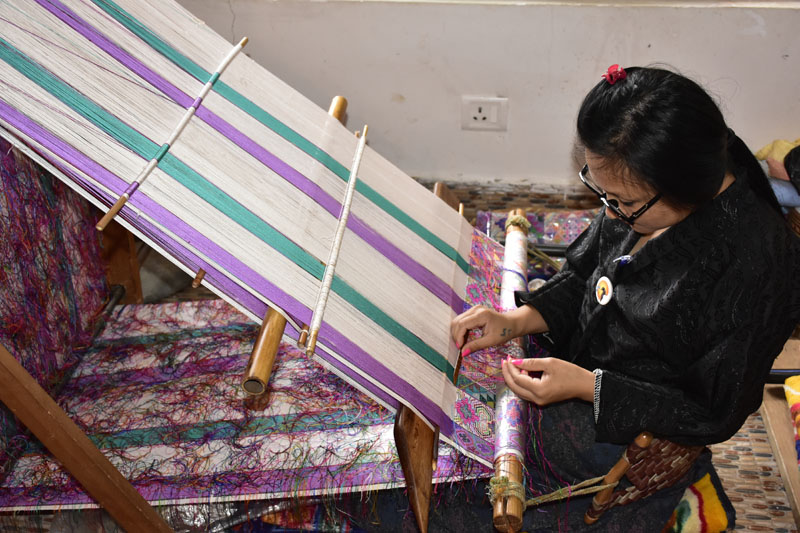

The Stunning Tiger Nest’s Monastery
If a mountain trek isn’t your cup of tea, you can relax at the hotel. After a couple of days of acclimating in Paro, and the visit to the Tigers’ Nest we’ll drive to the ancient capital of Thimpu. There we’ll see the spectacular Royal Textile Academy’s museum of traditional clothing and cloth, and also visit a weaving studio.
Thimpu also has a good fabric shop offering glowing factory-woven brocades (think dragons and chrysanthemums) and other brilliant cloth used for festival blouses and temple hangings. After a couple of nights in the capital, we continue northeast to Punakha to see the majestic dzong or sacred temple complex built in the mid-1600s.
Then we head east across back-country Bhutan to the beautiful Bumthang Valley. Villages here are famous for the decorated wooden houses dotted among verdant agricultural valleys. Along the way from west to east, we’ll visit many weaving households and handicraft coop organizations to learn about the incredibly labor-intensive weaving techniques.
Then we head eastward in central Bhutan, by way of Trongsa. Along the route, we will visit some wool weavers and dyers making yathra or heavy warm cloth with supplementary weft patterns, The whole eastern region is not visited much compared to the west.
In the past, by government decree both men and women wore traditional handwoven outfits. This regulation has now been loosened, and usually only government workers and students wear the national dress daily. Today the best place to see the most exquisite kira and men’s handwoven gho robes, is at the festive Buddhist celebrations that we will attend.

Buddhist Tshechus • Festivals
One thrilling highlight of the itinerary is attending two festival events called tshechus, with masked dancers in brilliant embroidered costumes. Spectators sit around the edges of temple courtyards to watch the dances, and it is very orderly, with dancers whirling and cavorting in the center. Costumed monks perform didactic Buddhist legends, wearing carved wooden masks and brilliantly appliquéd and embroidered outfits. Others play the long collapsible horns called dungchen.
These events typically provide fabulous photo-ops. We will have cushions to sit on, but you can stand or walk around and get better photo angles. Some people like to stay all day and watch the dancing, and others want to wander in the dzong and admire the paintings and Buddha statues, or relax at the hotel.
The Wonders of Eastern Bhutan
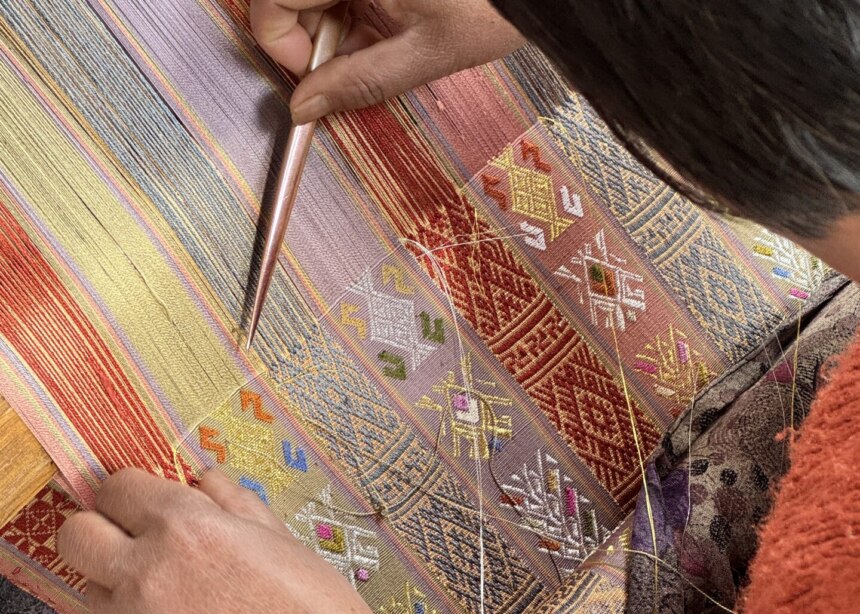


The whole eastern region is relatively remote compared to the west. There are hundreds of weaving families dwelling in villages in the area. The Queen and Queen Mothers even order their royal kiras from weavers here! Along our route, we’ll visit many of the weaving households and handicraft coop organizations to learn about the incredibly labor-intensive techniques used to make the women’s kiras and the ghos for men.
We’ll meet a family specializing in natural dyes (madder, indigo, etc) and find out how they use the dyes on big tan-brown wild silk cocoons, nothing like the pure white cocoons we sometimes see. There will be examples of their exquisite work available to purchase too. We’ll also have a delicious lunch with them.
Traditional festivals or tshechus are also highlights of this area; we plan to attend two local celebrations and any others that we come across. Leaving Lhuntse, we’ll head to two small towns for their tshechus. These festive events are the best places to see exquisite kira and men’s handwoven gho robes because everyone is wearing his or her very best new clothing for the annual celebration.
Later we’ll drive south across the border into India, saying Goodbye to lovely Bhutan, our guide and the driver. We’ll be met at the border and we’ll drive to the Guwahati airport to fly to Delhi to connect for our flights home! The flight from Guwahati to Delhi is included but don’t forget you need a multiple entry visa for India. This is done online and is easy; info will be sent. We’ll go home on our connecting flights from Delhi. TBA
Where You Will Be Staying

Hotel at Paro
Traditionally decorated wooden buildings built on an eight-acre property on the banks of the rushing Pachu River. Each structure houses spacious rooms with typical decorations. The hotel offers excellent buffet meals. Only 10 minutes from Paro town and an hour from the capital, Thimpu.

Mountain Lodge Resort
Mountain Lodge is a stunning new stone and wood building with a light-filled restaurant and a fine rustic lobby with roaring fireplace. Rooms are spacious, with high ceilings, good linens, and modern bathrooms. The restaurant here is excellent also.
Additional Details & Experiences
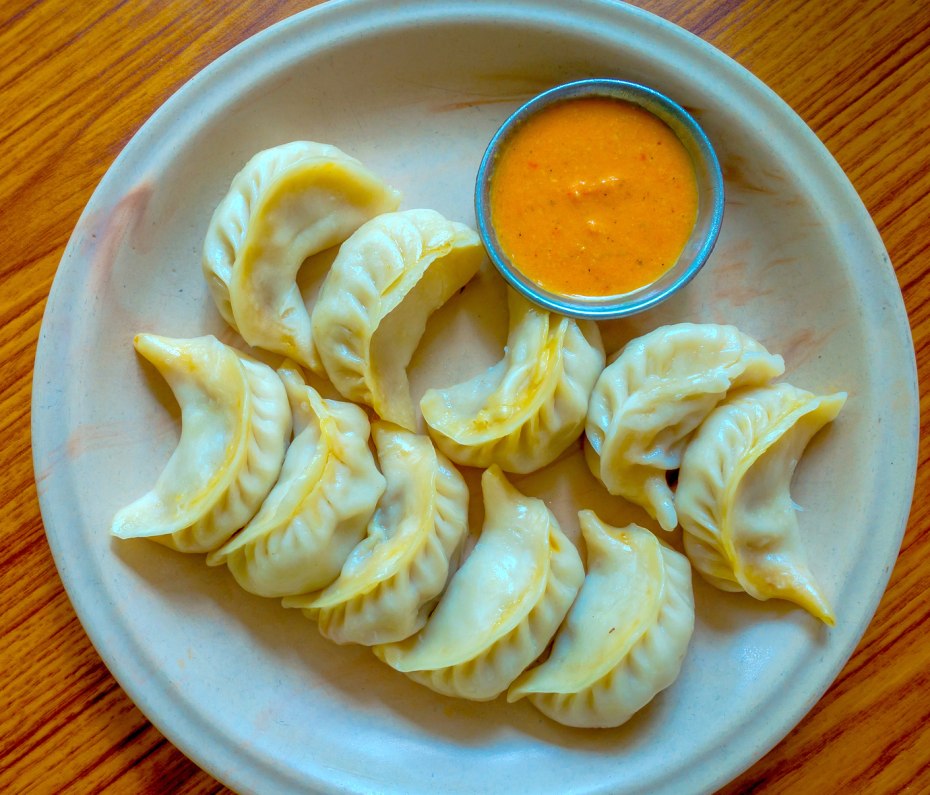
What Kind of Food Is Served in Bhutan?
Dinner will often be a buffet at our hotel, where you can taste a variety of new dishes. Some foods are hot-spicy, but usually we as travelers will be served mild versions. Momos, steamed dumplings like Chinese potstickers, are very common and popular everywhere for lunch. They’re stuffed with ground meat or a tasty mixture of onions and other vegetables. Momos are great with spicy chili-soy dipping sauces.
A chili and cheese dish called Ema Datshi is the tasty ‘national dish’ and it ranges from mild to blazing hot. It’s best eaten with rice to counter the heat, but in our hotels the food will be medium to mild. Kewa Datshi is potatoes with chili, also delicious! Roasted eggplant is a common and delicious dish in season.
Rice and/or buckwheat noodles are present at all meals, and sauteed vegetable mixtures and soups are also served. Chicken or beef are the most common meats, often served stir-fried. Dessert might be fruit or cake or pudding.
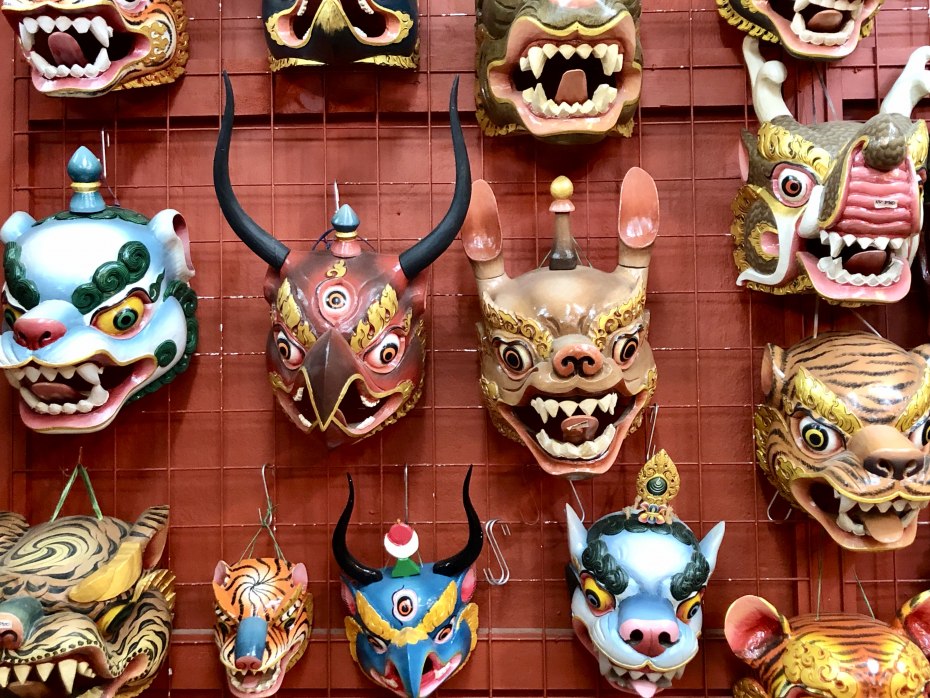
What Treasures Are There to Buy in Bhutan?
Hand-woven cloth in exquisite saturated colors and complicated geometric patterns is a popular choice. Prices on handwoven textiles at first seem high, but when you see the complex weaving processes and detailed color changes, you’ll understand why they charge the price! In some villages, we can purchase the hand-woven textiles directly from the weavers, so they end up with all the money for their efforts.
In addition to cotton and silk weavings, artisans make delightful tiger-shaped pile rugs and thick woolen weavings called Yathra which could be used for chair cushions or couch pillows. Decorated felted boots and slippers are popular purchases, as are the hand-carved wooden animal masks like the ones worn at the festivals. And brilliant commercially -woven brocade yardage and other silky fabrics on bolts crowd the shelves of several wonderful shops in downtown Thimpu. This cloth could be used for all sorts of projects from blouses and robes to quilts.
Confessions! I have been on NINE of Cynthia’s trips: Turkey several times, Peru, Bolivia, Thailand, Laos, Morocco, Mali and most recently Bhutan. You might ask why I keep returning! It’s because on each trip I arrive home having had the most incredible time. Always I’ve met interesting people, stayed in small, boutique hotels and visited the usual tourist sites, but because of Cynthia’s ability to strike up hard and fast friendships with her guides and drivers, hotel personnel, shop keepers, and crafts people, we experience an in-depth appreciation for the countries’ history, culture and especially of textile arts and crafts.
Anne Duffey – Davis, CA
Your Trip Leaders

Sonam
Sonam and Tej, the Behind the Scenes Adventures guide and driver team help to make every trip to the ‘Land of Happiness’ a superlative experience. Sonam’s positive energy, sense of humor and upbeat personality make him a joy to travel with – plus he knows helpful and friendly people everywhere. With his knowledge of the Dzongkha language, he can translate to English even the complicated explanations of natural dye sources or special techniques when we meet weavers in remote villages.

Tej
Tej is our patient, careful and cheerful driver who not only knows all the backroads, but graciously expands his job description to include climbing to Tiger’s Nest to help us with the ascent, setting up a picnic site, dividing two weavings evenly, pouring tea, serving momos and more!
Both Tej and Sonam speak a Bhutanese language called Dzongkha, which is very helpful when we are in remote eastern villages. Bhutan is a small country and these two know everyone!

Cynthia
Cynthia began “Behind the Scenes Adventures” to share with others the traditional textiles and festivals of far-flung countries. The intricacies of design and color of the Bhutanese weaving techniques amaze her and she is still learning the complex techniques. She’s been going to Bhutan with Sonam as the guide for many years. His cheerful, good-natured outlook and exhaustive knowledge of Buddhism and the customs of Bhutan make the trip a delight!
Check Trip Availability
Trip signups are accepted on a first-come, first serve basis. Please provide your details below and we’ll be in touch to confirm whether spaces are still available for this trip. If you need to get in contact, please email: info@btsadventures.com
Registration Information
- Dates: Nov. 15 – Dec. 2, 2025
- Fly Home Date: December 3, 2025
- Deposit: $500
- Tour Cost: 18 Nights From $6895
- Single Supplement: $880
For more information:
E-mail: info@btsadventures.com
Read: Frequently Asked Questions
Visas
Our visas for Bhutan will be processed quickly and efficiently by the trusted Bhutanese travel agent, without having to send your passport anywhere.
Typically your BHUTAN visa will be sent by email to your email address and you should PRINT it out. It’s a single piece of official-looking paper that you will keep with your passport. Note that there is no other way to get a Bhutanese travel visa, and that travelers to Bhutan are well-tracked and accounted for by the official Tourism Bureau.
NOTE: Arrival and departure flights should connect in New Delhi. We fly as a group on SPECIFIC flights to Paro, Bhutan, to keep the group together. We will email copies of the group plane tickets (everyone in one list). You must print out the list; that is your ticket to Paro!
Try to find flights to and from the US that do not require an overnight in Delhi…there is a Holiday Inn right in the airport which is very convenient, if you must spend a night…or you can hang out in one of the restaurants.
What’s Included
- Visa for Bhutan; the travel agent will apply for our visas, which is much easier for us. We need to send him copies or scans of our passports’ first page.
- All accommodations: 18 nights in comfortable hotels in double/twin rooms with private bath.
- All meals (often buffets in our hotels) and some picnic lunches in weaving villages, with families.
- All bottled water & soft drinks with meals
- Airport transfers for arrival and departure flights on official dates
- Two flights – from Delhi to Paro at beginning of tour and from Guwahati to Delhi at the end.
- English-speaking Bhutanese licensed guide
- All in-country ground travel by good Toyota mini-bus with professional driver
- Bottled water available in the van at all times; roadside tea breaks are included
- Horseback transport to Tiger’s Nest Monastery tea house; everyone must walk down the path to descend.
What’s Not Included
- International airfare
- India double-entry E-visa
- Alcoholic beverages
- Tips for guide and driver (suggested amounts later)
- Personal items such as laundry, postcards, between-meal snacks or drinks; we will have included tea stops on the road occasionally.
Frequently Asked Questions
General Questions
What information will I receive after registering?
Once you sign up for a trip, we will e-mail a general itinerary, lists of Suggested Reading, what to take, cultural considerations, weather charts, etc.
How can I get a detailed itinerary for a tour?
A day-to-day itinerary will be sent once you sign up for a trip. If you need specific information about the flow of the trip and the pace of the specific activities, before committing to the trip, get in touch with your questions and we will be happy to fill you in.
What sort of clothing should I bring?
When you sign up for a tour, you’ll receive detailed lists of what to bring to your destination, as well as weather info, to more easily coordinate your wardrobe with the heat or cold.
Bhutan can be very cold in the mountains during the winter. For quick basic guidelines: Bhutan is a conservative Buddhist country, not as conservative as some destinations, but nevertheless, it is better to cover your shoulders with short or long sleeves. Pants and skirts should be at least to your ankles. Tops/blouses/shirts should be long enough to cover your bottom to mid-thigh.
Bring simple, comfortable clothing, but you don’t need to wear outdoor, trekking clothes – except for the day when we hike up to the Tiger’s Nest Monastery. And even then, thick-soled shoes with good tread are the most important item. You will probably want sturdy pants if you plan to ride a horse up the trail.
What sort of clothing should I bring?
When you sign up for a tour, you’ll receive detailed lists of what to bring to your destination, as well as weather info, to more easily coordinate your wardrobe with the heat or cold.
Do I need any vaccinations or immunizations?
This varies with each country. Make an appointment with your travel doctor/clinic and take your tour itinerary with you. Some areas of certain countries require malaria pills and others do not; same with Yellow Fever and others, such as Cholera and Typhoid. The travel nurse or physician will have all the latest requirements at hand.
OR You can consult the CDC.gov (Center for Disease Control) website information pages for your specific destination so that you have the latest official information.
For all travel, you should be current on your typical childhood and international travel shots such as Polio and Tetanus. Some countries require proof of Yellow Fever vaccination for entry, if you are coming from a country that has yellow fever.
Behind the Scenes Adventures requires you to have had at least two COVID vaccinations. We won’t ask for proof; this requirement is on the Honor System. We recommend you have all available boosters as well.
How much physical activity is involved during the trip?
Each trip has different activity levels that will be fully explained in the specific tour material. But no activities or events are mandatory, and you are always welcome to sit at the bottom of the stairs to a temple or wait in the van while others ascend or visit a particular place. Walking sticks are fine to bring if they help you. We cannot accept wheelchairs or walkers.
For most tours, you’ll need to be able to walk the distance of 4-5 city blocks on your own, with sturdy shoes. Please note that sidewalks in many countries are full of big holes and broken cement chunks, with bits of re-bar sticking out, and you must constantly be alert to these dangers. In urban areas where distances are greater, the group will take taxis and/or get help from local assistants. If you need a personal taxi or additional special aid, that will be at your expense.
In more rural areas when we visit a remote village or temple, you should be able to navigate rocky routes, such as the dirt paths of Khoma village. You can always sit on a chair or bench if available, and wait for the rest of the group. It’s possible to bring and use folding walking sticks. It won’t be possible to use walkers, wheelchairs or crutches while traveling with a group. Most foreign destinations don’t have facilities for handicapped persons and we don’t have support personnel.
What will the weather be like?
Our trips are planned for great festivals and reasonably good weather. The weavers work all year round so we can visit them any time. But some of the best festivals take place during the winter months when snowy scenery and landscapes are also spectacular. When you sign up, we’ll send you weather and temperature charts as well as suggestions for warm clothes that will keep you comfortable if you travel during winter months.
Meals & Accommodations
What sort of hotels will we be staying in?
We start this trip in the east of the country, where we find the most rustic lodgings – and the most weavers! The quaintest hotel in the eastern region has small cozy rooms with knotty pine walls. Yet the restaurant here turns out amazing savory food; the best eggplant dish I had in Bhutan was made by the cook here! In the capital of Thimpu, we stay in a modern hotel with comfortable beds, good linens and modern bathrooms. In nearby Paro, we stay in individual pine cottages in an evergreen forest; the cottages are painted and decorated in the typical Bhutanese style. This place also has a good restaurant. Later in the Bumthang Valley we spend our nights in a new, deluxe stone and wood hotel with cushy beds and sleek modern bathrooms.
What sort of food will we be eating?
Bhutanese food is delicious but not as varied as the cuisine of nearby countries such as India. Red or white rice is a staple, and handmade, chewy buckwheat noodles and pancakes are popular. Ema Datshi is the national dish, a hot mix made from chilis and cheese and it can be very spicy. It’s yummy but a little goes a long way. Datshis are also made with potatoes and mushrooms, among other vegetables.
Momos, similar to Chinese potstickers, are very popular. They are handmade with different stuffings – meats or vegetables like cabbage, or cheese. Momos are either steamed or deep-fried and crispy. All of them can be enhanced with a chili sauce and they are delicious for lunch or a snack. Momos are eaten with hot chili sauces.
Will I be able to accommodate my dietary needs?
If you have any special dietary, health, or nutrition issues, restrictions, etc, there is no guarantee that
Behind the Scenes Adventures will be able to accommodate your special diets in foreign countries.
Please contact us before departure, and bring sufficient alternative foods. Travelers with severe peanut allergies or other life-threatening allergies cannot be accepted. Vegan diets are possible but with much less variety than at home. Vegetarian or gluten-free diets are often fairly easy to accommodate, but also with less variety than what is available at home. Note that the guide and tour leader cannot cater to your special diet in a group; you’ll be responsible for choosing foods you can eat.
Flights & Travel
Will I need a visa for connecting countries?
Yes! We will enter Bhutan through India and you will need a Multiple-Entry visa to enter and depart INDIA. We’ll send you information on how to apply for your electronic visa for India. We’ll need to send copies of our passports’ first page to the travel agent who will procure our visas and hand them to us when we enter the country by plane into Paro, Bhutan. The fee for the Bhutan Visa is included with the trip cost, but the Multiple-Entry visa for India is not included.
We will enter Bhutan with a flight from New Delhi. If we need to connect in India, you will need a multiple-entry visa for India, cost not included.
Once you sign up for the tour, you will be sent the website link to get your India e-visa online. Use the official INDIA Government website for visas, not an expensive visa service.
Or if you want a 10-year visa, you can fill out the forms and send your passport to the nearest visa office. You can do this anytime soon as long as you won’t need your passport for about 2 weeks.
What are the requirements for my passport to be valid?
Your passport needs to have one blank page for your visa, although, with an E-Visa, you will have just a piece of paper to show, and don’t need room for anything except Immigration stamps in your passport.
Will I be met at the airport?
Yes! A driver (and the guide if possible) will meet you with a sign – beariing your name and/or Behind the Scenes Adventures. The driver will have your flight schedule and he will know that you need time to pick up your luggage. Wait for him in the terminal, right outside the Arrivals area, and don’t go with any other drivers that don’t have your name on a placard.
For each trip, we’ll send more specific info about the exact pick-up spot. The driver will help with your luggage and a small tip of $5 USD would be appreciated anywhere..
What is the best airline to fly to the country?
Once you sign up, and we plan where we will enter Bhutan (east or west, depending on the festivals), we’ll send information about suggested flights. For trips that begin in Eastern Bhutan, we typically fly to New Delhi first, then take a short flight to Guwahati, India, and drive in a van over the border into Bhutan.
For trips that begin in the West, we usually fly into New Delhi on United or other airlines, then fly directly into Paro, on Bhutan Airlines or Druk Air, perfectly reliable companies.
I find the 15 hour non-stop flight far toooo long from JFK or Newark so prefer a flight that stops in Europe; changing planes seems less painful than 15 straight hours, unless you are in Business Class!
What will we use for transportation?
In Bhutan, we use a roomy and late model Toyota van of a sort not seen in the USA. It has 12-15 seats and there are photos of it on the website. The van is driven by our professional and courteous driver and is as comfortable as possible on bumpy mountain roads.





